Sarah Emsley's Blog, page 5
February 7, 2025
“A more convincing consolation”
“Austen’s clear eyes and sharp nib make the predictable miraculous,” Francesca Segal says of Persuasion, which she names as one of the books on her “ultimate literary comfort reading list.” I like the distinction she makes between “solace” and “escape”: she says she doesn’t want a “temporary palliative,” but “a more convincing consolation, grounded in real life.”
“The best books,” Segal writes, “rebuild our strength so we can face reality, and maybe even fight to change it.” As Sheila Johnson Kindred and I argued in an essay on Mansfield Park several years ago, reading Austen may be both unsettling and comforting. We wrote that it is “possible to read Jane Austen just for fun, just for an escape from the stresses, and the terrors, of our own twenty-first century world. But when we read the novels attentively, we can see what Austen has to say about confronting, rather than escaping, misery. Hilary Mantel is wrong when she says that ‘No one who read it closely was ever comforted by an Austen novel.’ Reading Austen’s novels closely may well offer more comfort.”
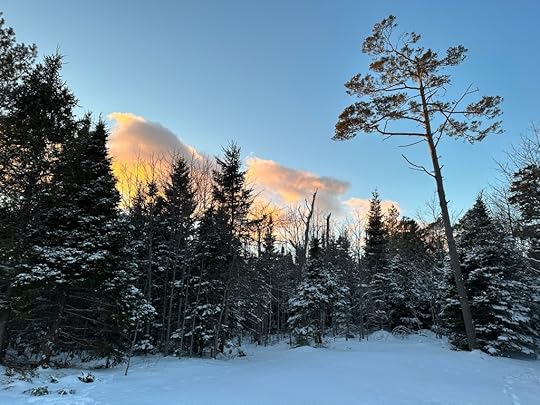

Segal’s list appeared in The Guardian last fall: “‘It will renew your faith in humanity’: books to bring comfort in dark times.”
The essay Sheila and I wrote was based on the talk we gave at the 2014 JASNA AGM in Montreal, “Among the Proto-Janeites: Reading Mansfield Park for Consolation in Halifax, Nova Scotia, in 1815.” Lady Sherbrooke, wife of Sir John Coape Sherbrooke, Lieutenant Governor of Nova Scotia, read Mansfield Park aloud to her friend Mary Wodehouse after the death of Mary’s first child.

I’m looking forward to next week’s installment of “Unexpectedly Austen,” the series of tributes I’m co-editing with Liz Philosophos Cooper. It will be posted on the JASNA website on Tuesday, and I’ll share excerpts here in next Friday’s blog post.
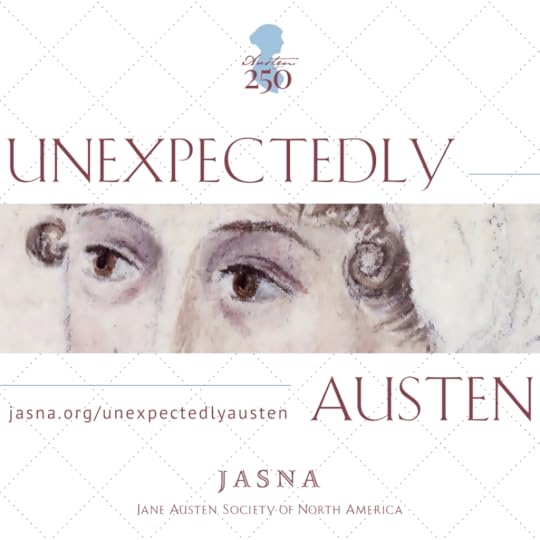
I took the photos that accompany this post on another of “my winter walks” in Point Pleasant Park.

If you enjoyed this post, I hope you’ll consider recommending it to a friend. If you aren’t yet a subscriber, please sign up!
Here are the links to the last two posts, in case you missed them:
“My winter walk” (Mr. Woodhouse, Cowper, Point Pleasant Park in winter)
“That sea of wonders” (Edith Wharton’s birthday)
Read more about my books, including St. Paul’s in the Grand Parade, Jane Austen’s Philosophy of the Virtues, and Jane Austen and the North Atlantic, here.
Copyright Sarah Emsley 2025 ~ All rights reserved. No AI training: material on http://www.sarahemsley.com may not be used to “train” generative AI technologies.
January 31, 2025
“My winter walk”
Echoing a phrase from the poetry of William Cowper, one of Jane Austen’s favourite poets, Mr. Woodhouse tells Mr. Knightley that he intends to go out and “take my three turns—my winter walk” (Emma, Volume 1, Chapter 8). I thought of Mr. Woodhouse and his winter walk when I “took a turn” about Point Pleasant Park the other day.

In The Task, Cowper says that winter smiles, “resigning all its rage / And has the warmth of May.” Although our weather here in Nova Scotia did not have the “warmth of May” that day, I think the season still seemed to be smiling.
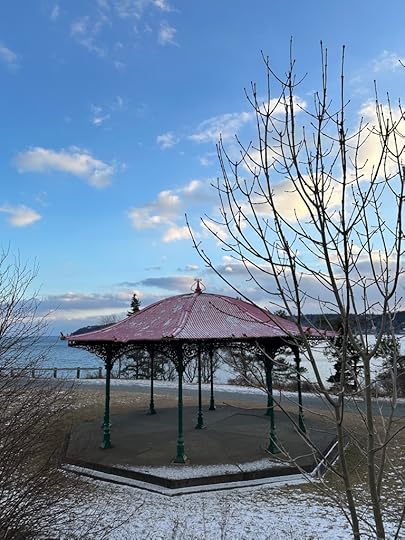

Today I also want to share a link to a recent blog post by my friend Sheila Johnson Kindred, author of Jane Austen’s Transatlantic Sister: The Life and Letters of Fanny Palmer Austen. In “Captain Charles Austen: Agent of British Diplomacy in South America,” Sheila tells the story of Jane’s youngest brother, Charles (husband of Fanny Palmer Austen), receiving a ceremonial sword as a gift from General Simon Bolivar in 1827.
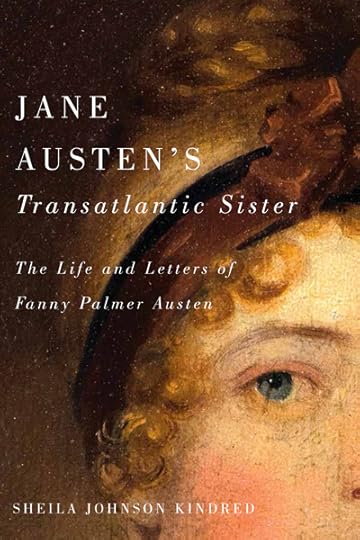
If you enjoyed this post, I hope you’ll consider recommending it to a friend. If you aren’t yet a subscriber, please sign up!
Here are the links to the last two posts, in case you missed them:
“That sea of wonders” (Edith Wharton’s birthday)
Unexpectedly Austen (a series of tributes to Jane Austen on the JASNA website, co-edited by Liz Philosophos Cooper and me)
Read more about my books, including St. Paul’s in the Grand Parade, Jane Austen’s Philosophy of the Virtues, and Jane Austen and the North Atlantic, here.
Copyright Sarah Emsley 2025 ~ All rights reserved. No AI training: material on http://www.sarahemsley.com may not be used to “train” generative AI technologies.
January 24, 2025
“That sea of wonders”
Edith Wharton was born 163 years ago today, on January 24, 1862, in New York City. I’ve been rereading her autobiography, A Backward Glance (1933), enjoying her descriptions of the books she read when she was young. Forbidden to read a novel without her mother’s permission, she writes that the “wide expanse of the classics, English, French and German” stretched before her instead, and she “plunged at will” into “that sea of wonders.”
Wharton says, “I was a healthy little girl who loved riding, swimming and romping; yet no children of my own age, and none even among the nearest of my grown-ups, were as close to me as the great voices that spoke to me from books.” She didn’t discuss this friendship with books and authors with anyone else: “There was in me a secret retreat where I wished no one to intrude, or at least no one whom I had yet encountered.”
I’ve also been reading/rereading articles on Wharton, including an essay from a couple of years ago by Emily J. Orlando, who writes of Wharton’s “uncanny anticipation of our culture,” suggesting that she “seems to have foreseen the excesses, obsessions, and spectacles of our current moment.”
I like Emily Temple’s tribute to Wharton and dogs, which includes details about Wharton’s dog cemetery; her dog ghost story, “Kerfol”; the poetry she wrote about dogs; and her work as an animal activist. Wharton wrote of her “deep, instinctive understanding of animals,” and believed she could communicate with her dogs. After her dog Linky died in 1937, she told a friend that “no one had such wise things to say as Linky.”
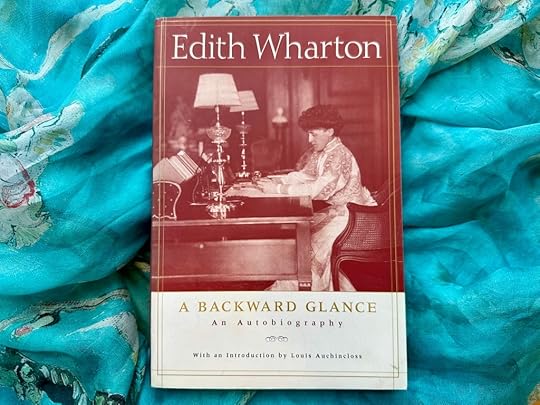
Here are a couple of other things I’ve come across recently, from my friends Shawna Lemay and Renée Hartleib, and saved to share with you.
Shawna says in a blog post that “Art helps, art is needed, art is necessary. Art is non-negotiable if we’re to get through.” Quoting a famous passage from Henry James’s story “The Middle Years,” in which the novelist Dencombe speaks of “work[ing] in the dark,” she writes that “we’re always working in the dark. We never know quite what will happen next. Still life reminds us to stay. Breathe. Attend. . . . Don’t give up. Don’t stop.”
(Shawna wrote “Of Sandwiches and Obligations” for my Sense and Sensibility blog series last summer.)
Those of you who are engaged in a writing project (or may be considering embarking on one) might be interested in a new program Renée’s offering, the Short Story Intensive. (If you’ve been reading my blog for a while, perhaps you’ll remember the guest post she wrote on “Words that Heal” in 2023.) In the Short Story Intensive, Renée’s “aim is to help writers take a short piece of fiction, poetry, or memoir to the next level, and one step closer to publication.” She says, “I love working one-on-one with writers and this new offering is short, simple, personal, and affordable.”

I’m sending you all best wishes for good conversations with books, pets, and artists—past, present, and future. Thanks for reading, and I’ll see you here next Friday.

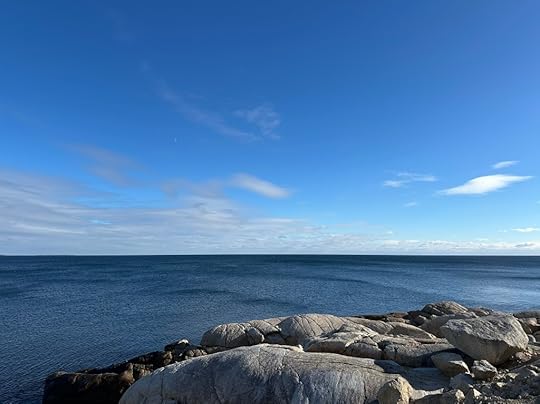
If you enjoyed this post, I hope you’ll consider recommending it to a friend. If you aren’t yet a subscriber, please sign up!
Here are the links to the last two posts, in case you missed them:
Unexpectedly Austen (a series of tributes to Jane Austen on the JASNA website, co-edited by Liz Philosophos Cooper and me)
“I bought maps in every town” (Nashville photos and Ann Patchett’s first novel, The Patron Saint of Liars)
Read more about my books, including St. Paul’s in the Grand Parade, Jane Austen’s Philosophy of the Virtues, and Jane Austen and the North Atlantic, here.
Copyright Sarah Emsley 2025 ~ All rights reserved. No AI training: material on http://www.sarahemsley.com may not be used to “train” generative AI technologies.
January 17, 2025
Unexpectedly Austen
This year is the 250th anniversary of Jane Austen’s birth, and readers and fans around the world are celebrating her life, works, and legacy. As part of the celebrations, Liz Philosophos Cooper and I are co-editing a series of tributes to and reflections on Austen by well-known members of the public. Each month, we’ll share a new installment of the series, “Unexpectedly Austen,” on the Jane Austen Society of North America website.
In the January installment, Pulitzer Prize-winning author Anna Quindlen writes that “Jane Austen is, and will always be, the improbable inimitable immortal,” and NBA star Dwyane Wade reflects on the enduring appeal of Pride and Prejudice and on “how a love story from Regency England could be relevant to a 21st century basketball player from the Southside of Chicago.”
Read the tributes in full on the JASNA website.
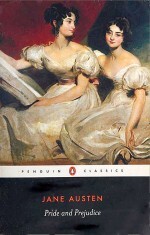
I’m excited about the series, and I hope you’ll follow along! I wish I could tell you all the names of the people who responded to our invitation to write tributes and reflections, but I’d better keep that a secret for now. I’ll share links to the monthly installments here on my blog.
As I’ve mentioned here in the past, to celebrate the 250th JASNA is offering free one-year Student Memberships.
I hope the new year is off to a good start for all of you, and I’m wishing you peace and happiness in the months ahead. I’ll end today’s post with some photos from a recent hike with my husband at Herring Cove Provincial Park.
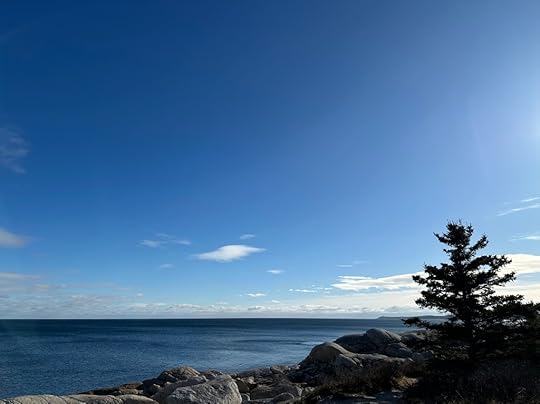

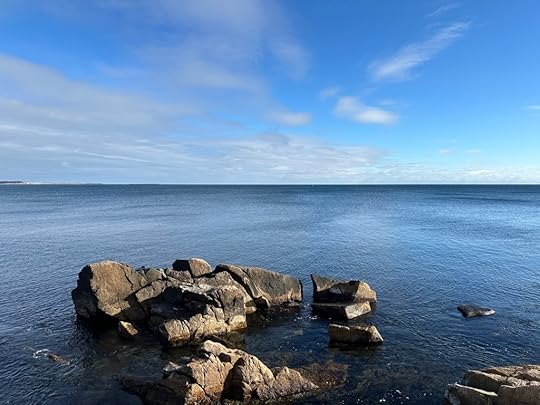
If you enjoyed this post, I hope you’ll consider recommending it to a friend. If you aren’t yet a subscriber, please sign up!
Here are the links to the last two posts, in case you missed them:
“I bought maps in every town” (Nashville photos and Ann Patchett’s first novel, The Patron Saint of Liars)
“The bells rang back through the woods” (Christmas in L.M. Montgomery’s Emily of New Moon)
Read more about my books, including St. Paul’s in the Grand Parade, Jane Austen’s Philosophy of the Virtues, and Jane Austen and the North Atlantic, here.
Copyright Sarah Emsley 2025 ~ All rights reserved. No AI training: material on http://www.sarahemsley.com may not be used to “train” generative AI technologies.
December 27, 2024
“I bought maps in every town”
In Ann Patchett’s first novel, The Patron Saint of Liars, Rose Clinton loves to drive. Although she “bought maps in every town,” Rose says, “I was never interested in where I might go, only the contours of the roads, the kind of lines they made, their shape and width, the views I imagined they would afford me.”
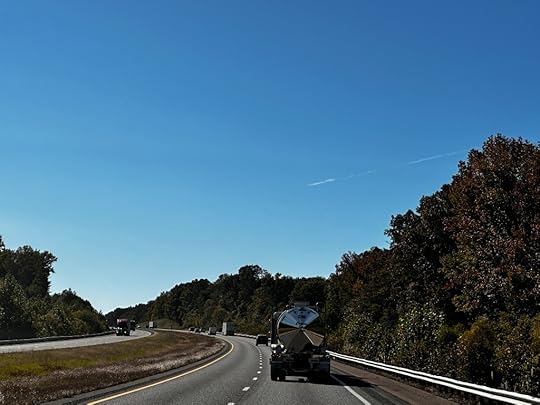
The bend in the road on I-40, somewhere between Nashville and Memphis (in the novel, Rose spends a lot of time on Highway 40)
In October, when I visited Nashville briefly, before and after my visit with my sister and her family in Oxford, Mississippi, I bought a copy of the novel at the bookstore Patchett owns, Parnassus Books.
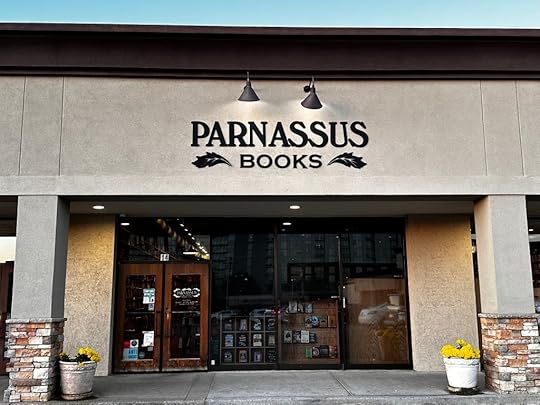
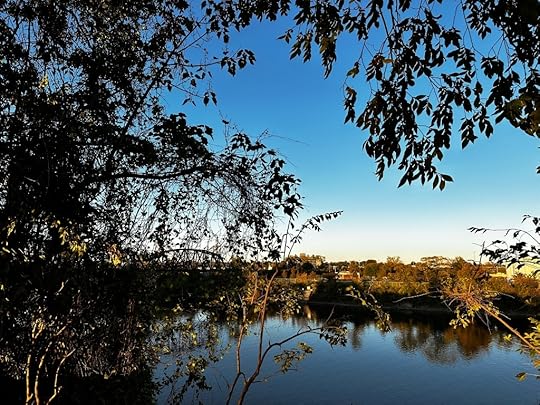
Cumberland River
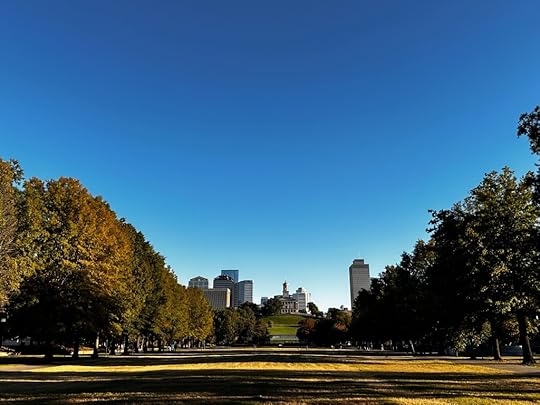
Tennessee State Capitol and Bicentennial Capitol Mall State Park
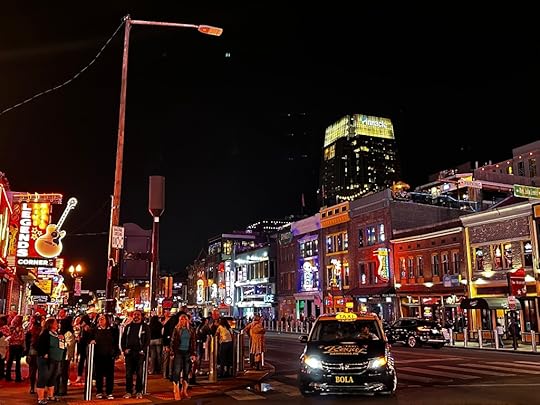
Honky Tonk Highway
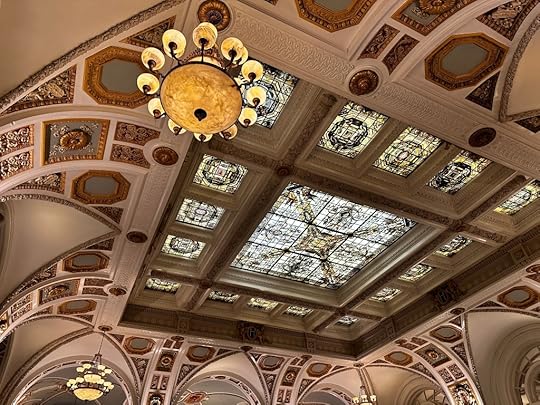
The Hermitage Hotel

Rose says, “People think you have to be going someplace, when, in fact, the ride is plenty.”
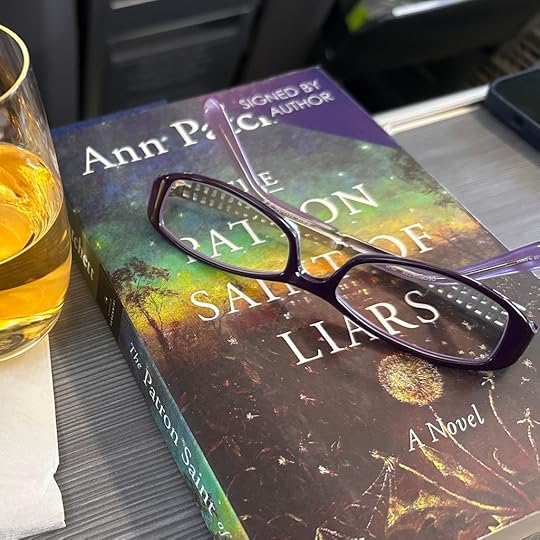
I enjoyed reading The Patron Saint of Liars on the flight home to Nova Scotia.
Thanks to all of you for reading my blog this year, and especially for celebrating Sense and Sensibility and L.M. Montgomery’s 150th birthday with me. I’m going to take some time off, and I’ll be back with a new post later in January. Best wishes to all of you for a wonderful new year, and for whatever lies beyond the bend in the road.
If you enjoyed this post, I hope you’ll consider recommending it to a friend. If you aren’t yet a subscriber, please sign up!
Here are the links to the last two posts, in case you missed them:
“The bells rang back through the woods” (Christmas in L.M. Montgomery’s Emily of New Moon)
“She placed her bonnet on his head & ran away” (my essay from the 2024 JASNA AGM, published in Persuasions On-Line)
Read more about my books, including St. Paul’s in the Grand Parade, Jane Austen’s Philosophy of the Virtues, and Jane Austen and the North Atlantic, here.
Copyright Sarah Emsley 2024 ~ All rights reserved. No AI training: material on http://www.sarahemsley.com may not be used to “train” generative AI technologies.
December 23, 2024
“The bells rang back through the trees”
On L.M. Montgomery’s 150th birthday, when I was reading passages at random from her novels and journals, I came across Emily Starr’s letter to her father about Christmas at New Moon and the moment at which she “didn’t feel like a stranger among the Murrays any more” (Emily of New Moon, Chapter 20). It’s an amusing letter—for example, she says her Aunt Elizabeth “looked quite handsome and I was proud of her. You like your relations to look well even if you don’t like them.” And the ending is beautiful.


Emily begins by saying that “Christmas is over. It was pretty nice. I never saw so many good things cooked all at once.” After all the celebrations have ended, Uncle Wallace asks everyone to “‘think for a few moments of those who have gone before.’”
Emily says, “I liked the way he said it—very solemnly and kind. It was one of the times when I am glad the blood of the Murrays flows in my vains. And I thought of you, darling Father, and Mother and poor little Mike and Great-great-Grandmother Murray, and of my old account book that Aunt Elizabeth burned, because it seemed just like a person to me. And then we all joined hands and sung ‘For Auld Lang Syne’ before they went home.” This is the moment at which—despite her sorrows, and her anger at Aunt Elizabeth—Emily no longer feels like a stranger in her new home.
At the end, she writes that when the visiting relatives left the house, “Aunt Laura and I stood out on the porch to watch them go. Aunt Laura put her arm around me and said, ‘Your mother and I used to stand like this long ago, Emily, to watch the Christmas guests go away.’ The snow creaked and the bells rang back through the trees and the frost on the pighouse roof sparkled in the moonlight. And it was all so lovely (the bells and the frost and the big shining white night) that the flash came and that was best of all.”
Merry Christmas to those of you who will be celebrating this week. I hope you’ll hear (or imagine) bells ringing or snow creaking or catch a glimpse of frost sparkling in the moonlight. Most of all, whether you’re celebrating Christmas or not and whether you’re in a snowy, frosty part of the world or not, I hope you’ll experience some of the peace that Emily describes here.
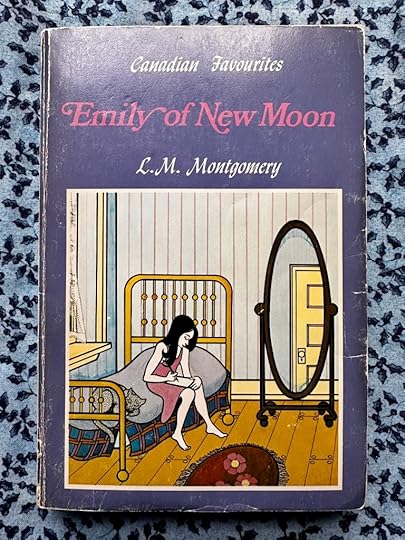
I’ll add a few photos my friend Kate Scarth took at Christmas at Green Gables in Cavendish, PEI, on L.M. Montgomery’s 150th birthday. Many thanks to Kate for sending these lovely pictures and for giving permission to share them with you here.
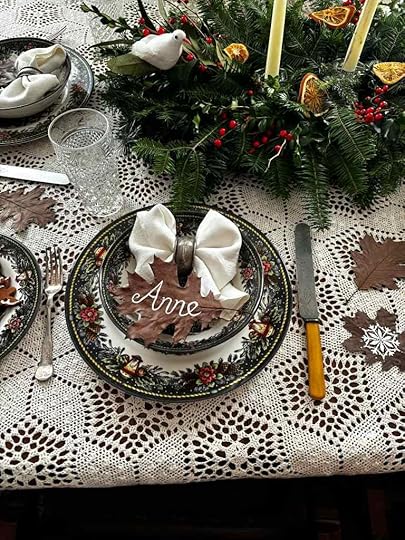

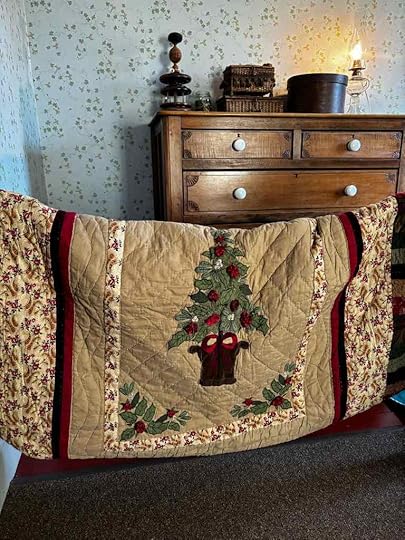
And I’ll end this post with a photo of the wreath I made at a workshop in Lunenburg recently, hosted by Svenja Dee of Tulipwood, along with photos of the holiday lights in the Halifax Public Gardens.

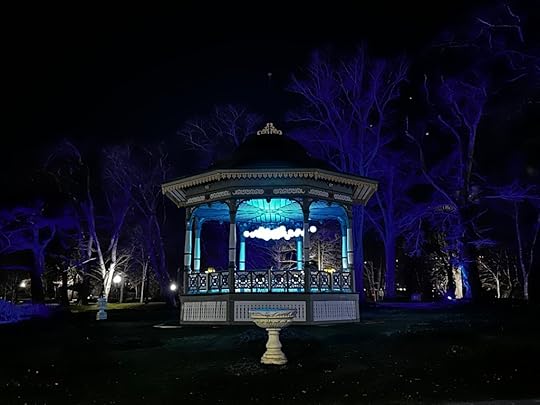
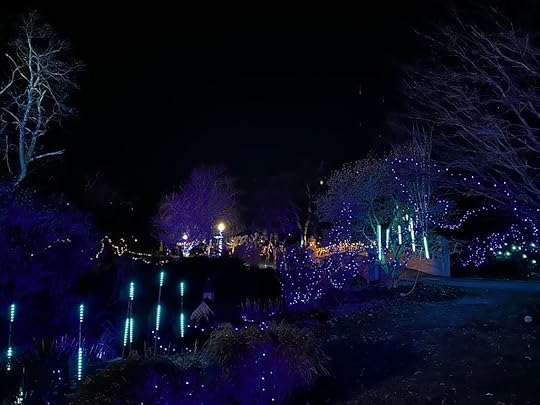
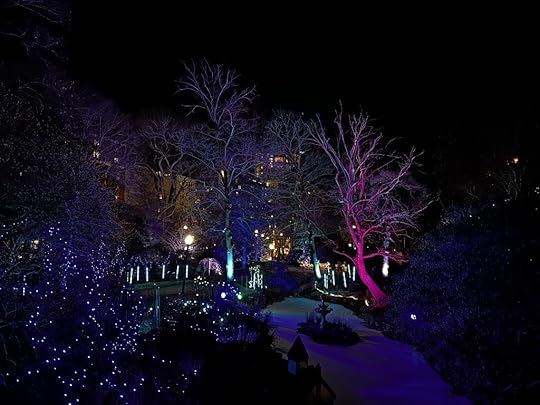
If you enjoyed this post, I hope you’ll consider recommending it to a friend. If you aren’t yet a subscriber, please sign up!
Here are the links to the last two posts, in case you missed them:
“She placed her bonnet on his head & ran away” (my essay from the 2024 JASNA AGM, published in Persuasions On-Line)
Happy 249th Birthday to Jane Austen!
Read more about my books, including St. Paul’s in the Grand Parade, Jane Austen’s Philosophy of the Virtues, and Jane Austen and the North Atlantic, here.
Copyright Sarah Emsley 2024; PEI photos copyright Kate Scarth 2024 ~ All rights reserved. No AI training: material on http://www.sarahemsley.com may not be used to “train” generative AI technologies.
December 20, 2024
“She placed her bonnet on his head & ran away”
The talk I gave in Cleveland earlier this fall at the JASNA AGM was published on Monday, in Persuasions On-Line 45.1 (2024). You can read it here: “‘She placed her bonnet on his head & ran away’: Stealing Sources and Avoiding Consequences.”
It’s a kind of companion piece to the essay on L.M. Montgomery I shared on my blog a couple of weeks ago, “Stories, Girls, and ‘The Vanished Years’”: both raise questions about where stories come from and who owns them.
In this essay, I start by quoting Margaret Drabble, who suggests that “The ‘writing life’ is a life of crime,” and I talk about Jane Austen’s story “The Beautifull Cassandra,” in which the heroine refuses to pay for the food she’s eaten or her ride in a hackney coach to Hampstead and back. Instead, she “knock[s] down the Pastry Cook and walked away,” and places the bonnet she’s taken (stolen?) from her mother’s shop on the coachman’s head and, this time, runs away. I love this short story, which Austen wrote when she was about twelve. She called it “a novel in twelve Chapters,” even though it’s under four hundred words.

The Beautifull Cassandra, by Jane Austen, illustrated by Juliet McMaster. (Now available from the Juvenilia Press; this cover is from the earlier edition, published by Sono Nis Press.)
Persuasions On-Line 45.1 includes several other essays from the 2024 JASNA AGM, “Austen, Annotated: Jane Austen’s Literary, Political, and Cultural Origins,” along with a Miscellany and a Jane Austen Bibliography for 2023 compiled by Sara L. Pearson, Claire Bellanti, and Robin Henry. I’d like to highlight two of the essays here.
I heard Lizzie Dunford speak at the AGM and I found her lecture fascinating. From “The Lost Austen Fairytales: An Introduction”:
“When I first opened the notebook that contains the Delightful Tales of Fairy Land, I had little idea of the research adventure on which I was about to embark—though after being introduced to their existence by Professor Kathryn Sutherland, I had long believed that they had the possibility to be hugely significant for our understanding of the work not just of James Edward Austen but also of his famous aunt Jane. For me, this notebook, and the Delightful Tales offer an entirely new angle on the reading and cultural hinterland of the extended Austen household. . . .”
Longtime readers of my blog will know that I am a big fan of Sheila Johnson Kindred and Hugh Kindred and their research on the Austen family and the Royal Navy, including Sheila’s book Jane Austen’s Transatlantic Sister: The Life and Letters of Fanny Palmer Austen. From “‘With Ships and Sailors She Felt Herself at Home’: How Jane Austen’s Siblings Stoked Her Naval Knowledge and Fired Her Creative Imagination”:
“Jane’s siblings provided her with access to naval information that no public source could offer. They were able to give her inside information from their personal experiences. Those experiences differed widely but added up to a much fuller description of naval service and operations, along with their impacts on the lives of the participants. . . . With the depth of knowledge her siblings collectively offered, is it any wonder that Jane might draw upon it in drafting her novels?”
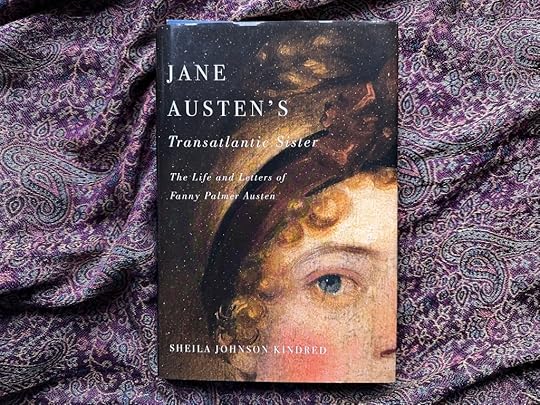
If you enjoyed this post, I hope you’ll consider recommending it to a friend. If you aren’t yet a subscriber, please sign up!
Here are the links to the last two posts, in case you missed them:
Happy 249th Birthday to Jane Austen!
“For the sake of writing the books” (Faulkner, Rowan Oak, Oxford, Ole Miss football)
Read more about my books, including St. Paul’s in the Grand Parade, Jane Austen’s Philosophy of the Virtues, and Jane Austen and the North Atlantic, here.
Copyright Sarah Emsley 2024 ~ All rights reserved. No AI training: material on http://www.sarahemsley.com may not be used to “train” generative AI technologies.
December 16, 2024
Happy 249th Birthday to Jane Austen!
Next year is the big one: Austen at 250, and I’ll have more to say about those celebrations soon. For now, let’s celebrate 249!
One of the ways the Jane Austen Society of North America (JASNA) is celebrating is by offering free student memberships for the rest of 2024 and through 2025. More details on the JASNA website. If you feel inclined to help spread the news to students who might be interested and teachers who might like to share this information with their classes, I’m sure the Society would be grateful.
I attended this year’s JASNA AGM and I was very happy to reconnect with old friends and meet new ones over a fabulous weekend in Cleveland. Brenda S. Cox put together a wonderful overview of the AGM for Jane Austen’s World, with lots of photos.
For me, one of the many highlights was a spontaneous picnic supper with a group of Janeites in one JASNA member’s hotel room. I’ll tell you the story because it unfolded in such a lovely way.
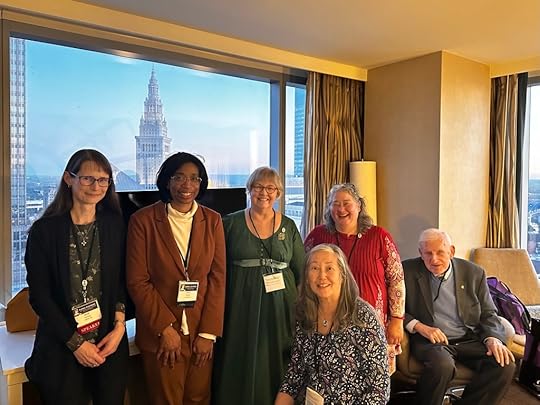
Left to right: Sarah, Marie, Becki, Alice, Joellynn, and Justin
I had been chatting with my friends Justin and Alice about meeting for dinner on Friday evening, but we hadn’t made any firm plans or reservations. Alice invited two of her friends as well, Marie and Joellynn, and the five of us set out to take the elevator to the restaurant on the 32nd floor of the hotel. On the long ride up, we ran into Cris, whom I had met at a bookbinding workshop earlier in the day, and I invited her to join us, too. The restaurant was closed for a private event—something related to the Rock & Roll Hall of Fame inductions that were happening that weekend, and we, alas, were not invited.
So we headed back down to the main restaurant and the hotel bar—both of which were packed with JASNA members and other hotel guests (including Kool & the Gang. . .). Alice says, “I remember the ‘Are you kidding me?’ look on the hostess’ face when I asked if seating was available for a group without a reservation.” We didn’t have time to explore other restaurants in the area, as there wasn’t much time left before the evening events (a presentation on “Jane Austen’s Wardrobe” by Hilary Davidson from the Fashion Institute of Technology, followed by a fashion show).
Fortunately, we discovered we could get takeout at the bar, and Cris generously suggested we have a picnic in her corner room on the 30th floor of the hotel, with its amazing views of downtown Cleveland. On the way there, Cris met another new friend, Becki, in the elevator, and invited her to join our group. Over our picnic supper we shared stories of how we discovered JASNA and which AGMs we’ve attended over the years.
I met Justin at my first AGM, in Colorado Springs in 1999, and Alice the last time I attended an AGM, which was in Washington, DC in 2016, and I’m delighted to have met Marie, Joellynn, Cris, and Becki at this one. I don’t know whether to quote Miss Bates here—“It is such a happiness when good people get together—and they always do” (Emma, Volume 2, Chapter 3) or Kool & the Gang: “Celebrate!”
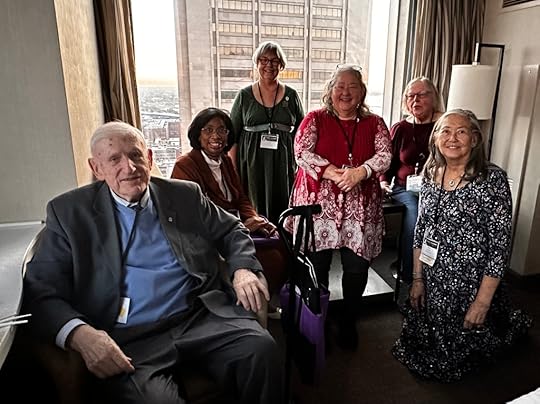
Left to right: Justin, Marie, Becki, Joellynn, Cris, Alice. I took this photo and Cris took the one above.
Cris took these photos from her room with a view:
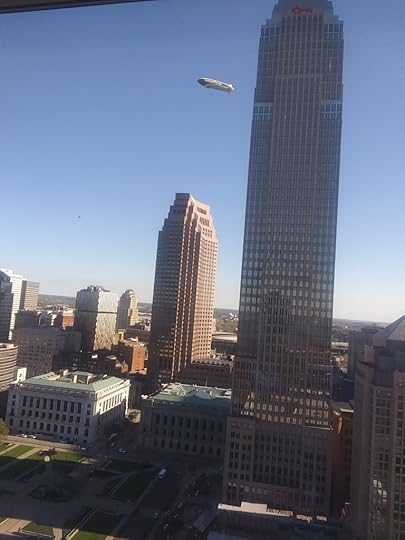

There were so many other highlights! I could tell you about the hotel security guard I chatted with, who hadn’t read Austen but told me one of his favourite books is the Diary of Anne Frank. Or I could describe the wonderful talks I heard. Or the banquet and the ball. Or the dance workshop I attended. I could tell you about the Regency ball gown I bought—my first! Which I haven’t worn yet—maybe sometime in 2025. . . .
But I’ll try to keep this post relatively short, and thus I’ll end with photos from the bookbinding workshop I mentioned earlier, along with photos of the ribbon rose I made in yet another workshop, me wearing that rose when I dressed for the banquet and ball, the sunset as seen from the hotel, and one more photo of our group.

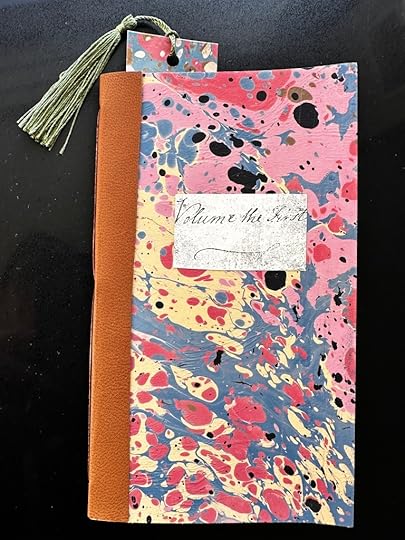
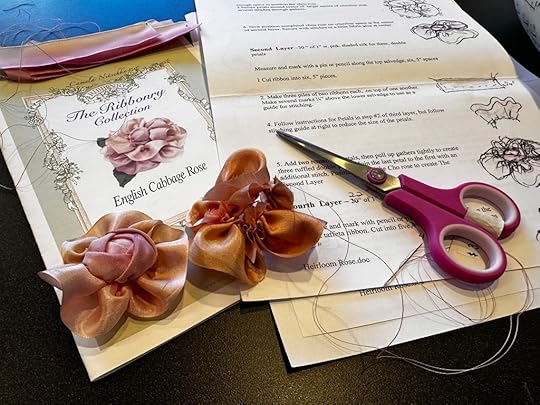



As Alice says, “we had lots of laughs trying to get a group photo.”
If you enjoyed this post, I hope you’ll consider recommending it to a friend. If you aren’t yet a subscriber, please sign up!
Here are the links to the last two posts, in case you missed them:
“For the sake of writing the books” (Faulkner, Rowan Oak, Oxford, Ole Miss football)
“The shock of their colliding shook the world” (the 107th anniversary of the Halifax Explosion)
Read more about my books, including St. Paul’s in the Grand Parade, Jane Austen’s Philosophy of the Virtues, and Jane Austen and the North Atlantic, here.
Copyright Sarah Emsley 2024 ~ All rights reserved. No AI training: material on http://www.sarahemsley.com may not be used to “train” generative AI technologies.
December 13, 2024
“For the sake of writing the books”
“It was 1923 and I wrote a book and discovered that my doom, fate, was to keep on writing books: not for any exterior or ulterior purpose: just writing the books for the sake of writing the books.”
– William Faulkner, from the Foreword to The Faulkner Reader (1953)
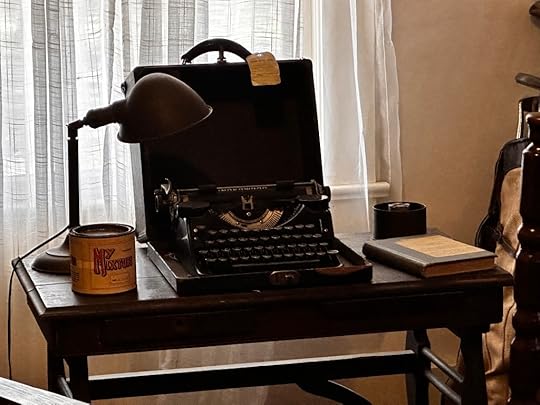
To me, Faulkner sounds a little bit like L.M. Montgomery’s heroine Emily Starr, who says, “Why, I have to write—I can’t help it by times—I’ve just got to” (Emily of New Moon, Chapter 31; coincidentally, the novel was first published in 1923). I feel the same way, and maybe some of you do, too? Writing for the sake of writing. Is it doom or fate? I don’t know, but I have to write.
Earlier this fall, I visited Faulkner’s house, Rowan Oak, on a sunny afternoon. (Here are the photos from my visit there last spring: “Would an expectation to read Faulkner be far off?”)
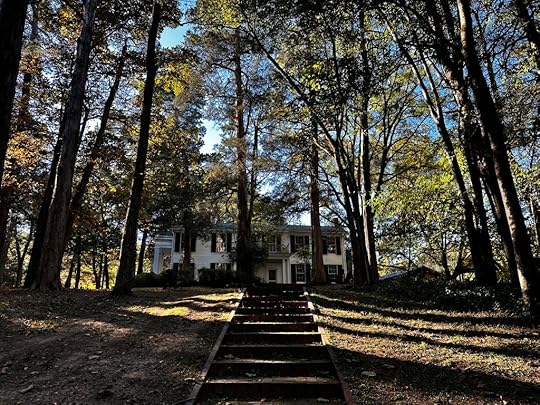

During our week in Oxford, Mississippi, my husband and I also went to an Ole Miss football game. I still don’t know much—or actually, anything at all!—about football, but I did find it fascinating to see crowds gather in the Grove on campus before and after the game, and to watch the whole spectacular event (including the marching band, cheerleaders, fireworks, and paratroopers landing on the field to deliver the game ball).
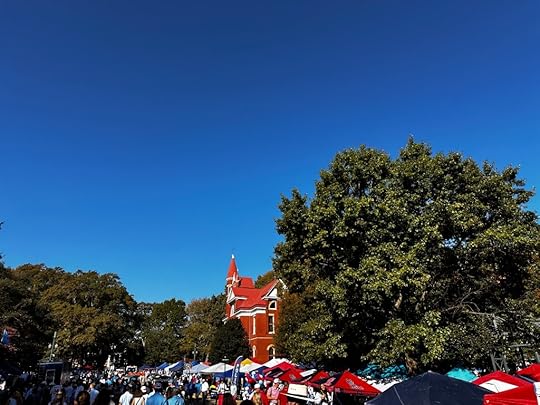


My sister Bethie and I had a really lovely dinner at a restaurant in Oxford called City Grocery.

And I enjoyed meeting up with my friend Susan at a café in Taylor, Mississippi, just a few days after we had seen each other at the Jane Austen Society of North America AGM in Cleveland.
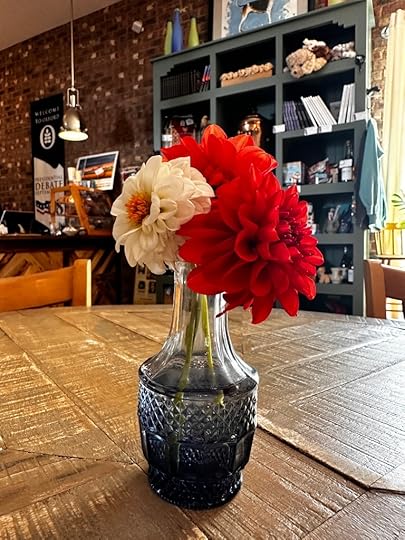
More about the JASNA AGM next time—I’ll share a few photos on Monday, which is Jane Austen’s 249th birthday.
If you enjoyed this post, I hope you’ll consider recommending it to a friend. If you aren’t yet a subscriber, please sign up!
Here are the links to the last two posts, in case you missed them:
“The shock of their colliding shook the world” (the 107th anniversary of the Halifax Explosion)
Christmas on the Grand Parade (an invitation to a concert at St. Paul’s Church, Halifax, on December 16, 2024)
Read more about my books, including St. Paul’s in the Grand Parade, Jane Austen’s Philosophy of the Virtues, and Jane Austen and the North Atlantic, here.
Copyright Sarah Emsley 2024 ~ All rights reserved. No AI training: material on http://www.sarahemsley.com may not be used to “train” generative AI technologies.
December 6, 2024
“The shock of their colliding shook the world”
Today is the 107th anniversary of the Halifax Explosion. The cannon on Citadel Hill will be fired at 9:04:35 a.m. to mark the precise moment the French munitions ship Mont Blanc collided with the Norwegian relief ship Imo in Halifax Harbour on December 6, 1917.
The Rev’d Samuel Prince, curate at St. Paul’s Church, Halifax, wrote that “It was as if some master fiend, playing with human lives as pawns, had tricked the vessels to their doom. Head on they swept into each other’s waters—into the embrace of death. There was a confusion of signals, a few agonized manouevres. The vessels collided—and the shock of their colliding shook the world.” The resulting blast, the most powerful man-made explosion that had ever happened (before Hiroshima), killed more than 1900 people, injured more than 9,000, and left more than 25,000 homeless.
St. Paul’s, which is now the oldest building in Halifax, stood strong even while many other buildings were destroyed or damaged. The church hall and the vestry were used as a temporary Red Cross hospital and the nave of the church was used as a morgue, with bodies piled around the walls. The clergy officiated at 127 funerals in that first month, more than in any other year of the church’s history.
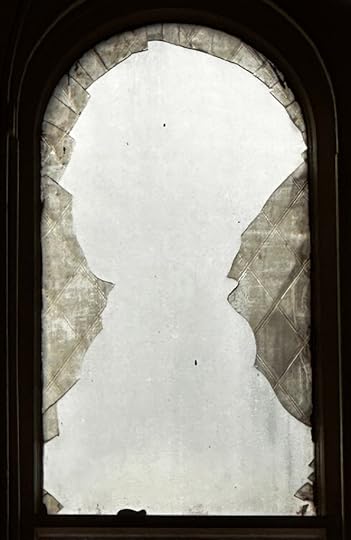
One window in the gallery of the church broke in an unusual shape that resembles a human profile, and the church preserved the broken shards between new panes of glass. Many ghost stories have been told about this window over the decades.
The bells at St. Paul’s, along with the bells of other churches, City Hall, and vessels in the harbour, will ring out for a full minute, beginning at 9:04:35 this morning.
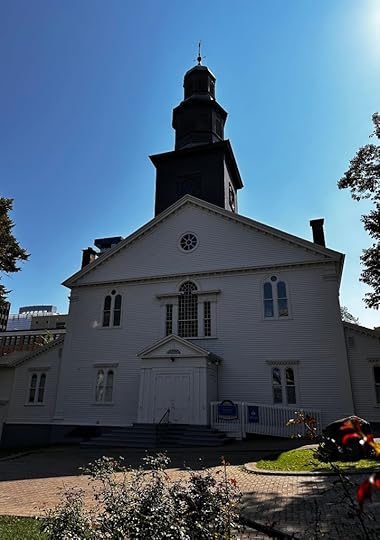
Some years ago, my friend Naomi MacKinnon compiled a Halifax Explosion Reading List, which includes several books I’ve read and admired, such as Carol Bruneau’s novel Glass Voices (you can find my review here), Steven Laffoley’s novels The Blue Tattoo and A Halifax Christmas Carol, Hugh MacLennan’s novel Barometer Rising, Jacqueline Halsey’s picture book Explosion Newsie, and Janet Kitz’s non-fiction account of the explosion and recovery efforts, Shattered City. Naomi has written about many of the books on the list and she provides links to her reviews.
A passage from Barometer Rising appears on Bookmark plaques (in English and French) from Project Bookmark Canada, which were unveiled on Citadel Hill in Halifax in 2017, the 100th anniversary of the Explosion. MacLennan’s protagonist looks down at the city from the top of the hill:
… the beauty of the world remained and he found himself able to enjoy it; it stayed a constant in spite of all mankind’s hideous attempts to master it.
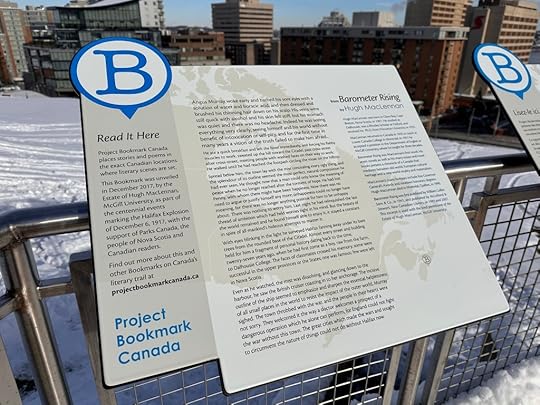

My friend Marianne Ward (on the right) and me, with the Project Bookmark plaques for Barometer Rising
A memorial service for those who lost their lives as a result of the Explosion will be held at Fort Needham Memorial Park this morning at 9:00.
Today is also the 35th anniversary of the École Polytechnique massacre and the 30th anniversary of the National Day of Remembrance & Action on Violence Against Women. There’s information in this article about events in Halifax today, organized in remembrance of the fourteen women killed in the massacre along with the many other victims of gender-based violence.

I took this photo in the Halifax Public Gardens last December, just before Marianne and I visited the Barometer Rising Bookmark
If you enjoyed this post, I hope you’ll consider recommending it to a friend. If you aren’t yet a subscriber, please sign up!
Here are the links to the last two posts, in case you missed them:
Stories, Girls, and “The Vanished Years,” by Sarah Emsley
Read more about my books, including St. Paul’s in the Grand Parade, Jane Austen’s Philosophy of the Virtues and Jane Austen and the North Atlantic, here.
Copyright Sarah Emsley 2024 ~ All rights reserved. No AI training: material on http://www.sarahemsley.com may not be used to “train” generative AI technologies.



